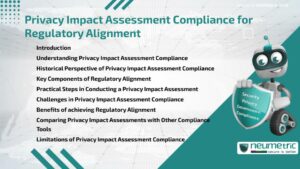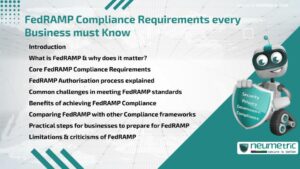Table of Contents
ToggleIntroduction
FedRAMP Compliance Requirements set the baseline for how Cloud Service Providers manage security when working with United States federal agencies. Any business aiming to serve Government Clients must follow these requirements to ensure data Confidentiality, Integrity & Availability. In this article, we will explain what FedRAMP is, outline the key Compliance Requirements, explore the Authorisation process, discuss common challenges, compare FedRAMP with other Compliance frameworks & offer practical steps to help businesses prepare. By the end, you will have a clear understanding of why FedRAMP Compliance Requirements matter & how to navigate them effectively.
What is FedRAMP & why does it matter?
The Federal Risk & Authorisation Management Program [FedRAMP] was established in 2011 to standardise security Assessment, Authorisation & Monitoring for Cloud products & services used by federal agencies. Before FedRAMP, each agency conducted its own evaluations, leading to inconsistent security standards.
FedRAMP solves this problem by creating a unified Framework that allows businesses to undergo one Authorisation process that can be reused across multiple agencies. This not only streamlines Government procurement but also boosts Trust between agencies & service providers.
Core FedRAMP Compliance Requirements
At the heart of FedRAMP Compliance Requirements are the National Institute of Standards & Technology [NIST] Special Publication 800-53 Security Controls. These cover areas such as:
- Access Control: Restricting System Access to authorised Users.
- Audit & accountability: Maintaining logs of User activity.
- Configuration management: Establishing secure baselines for systems.
- Incident Response: Preparing Procedures for Cyberattacks or Breaches.
- System integrity: Ensuring protection against Malware & Unauthorised changes.
Each requirement is tailored according to the impact level of the system: low, moderate or high. For example, a Cloud service hosting non-sensitive public data has fewer requirements than one managing classified defense data.
FedRAMP Authorisation process explained
The Authorisation process involves several structured steps:
- Preparation: Businesses document their systems & map them to required Controls.
- Assessment: A Third Party Assessment Organisation [3PAO] independently evaluates Security Practices.
- Authorisation: The Joint Authorisation Board [JAB] or an agency grants approval.
- Continuous Monitoring: Ongoing Audits & Reporting ensure Compliance does not lapse.
This cycle makes FedRAMP unique because it is not a one-time Certification but a living Authorisation. Agencies & Providers must remain vigilant at all times.
Common challenges in meeting FedRAMP standards
Many businesses underestimate the complexity of FedRAMP Compliance Requirements. Common hurdles include:
- High costs of Assessments & Audits.
- Time-consuming Documentation efforts.
- Navigating shifting federal security expectations.
- Limited availability of approved 3PAOs.
These challenges can discourage smaller businesses, but with careful planning & the right support, Compliance remains achievable.
Benefits of achieving FedRAMP Compliance
Despite the challenges, Compliance offers major advantages:
- Access to lucrative federal contracts.
- Streamlined procurement processes with multiple agencies.
- Enhanced reputation in both Government & Commercial markets.
- Improved internal security posture.
Businesses often find that the process of aligning with FedRAMP also strengthens their overall Cybersecurity resilience.
Comparing FedRAMP with other Compliance frameworks
FedRAMP is often compared with frameworks such as ISO 27001, SOC 2 & HIPAA. While all emphasise Data Protection, FedRAMP is uniquely tailored for U.S. federal needs. For example:
- SOC 2 focuses on trust principles like Privacy & Availability but lacks Government-specific Controls.
- ISO 27001 establishes an Information Security Management System [ISMS] but does not align directly with NIST 800-53.
- HIPAA governs Healthcare data but does not apply to broader Government data use.
Thus, businesses seeking Government contracts cannot substitute these Certifications for FedRAMP Compliance Requirements.
Practical steps for businesses to prepare for FedRAMP
Preparation involves several Best Practices:
- Conduct a Gap Analysis against NIST 800-53 controls.
- Choose the right impact level early to avoid over- or under-preparation.
- Engage with a 3PAO to clarify expectations.
- Build a culture of Continuous Monitoring, not just one-time Compliance.
Limitations & criticisms of FedRAMP
While effective, FedRAMP is not without criticism. Some argue that the program favors large providers due to cost barriers. Others note that Authorisation timelines can stretch for months, delaying innovation. Additionally, critics suggest that strict controls may sometimes stifle agility in Cloud adoption.
Acknowledging these limitations helps businesses plan better & balance Compliance with operational needs.
Takeaways
- FedRAMP Compliance Requirements are essential for businesses serving U.S. federal agencies.
- Core requirements stem from NIST 800-53 & vary by impact level.
- Authorisation involves Preparation, independent Assessment, Approval & ongoing Monitoring.
- Challenges exist, but benefits like access to contracts & improved security outweigh them.
- Comparing frameworks shows FedRAMP is unique to Government needs.
FAQ
What does FedRAMP stand for?
FedRAMP stands for Federal Risk & Authorisation Management Program.
Who needs to follow FedRAMP Compliance Requirements?
Any Cloud Service Provider working with U.S. federal agencies must comply.
What are the impact levels in FedRAMP?
They are low, moderate & high, depending on the sensitivity of the data being handled.
How long does it take to achieve Authorisation?
It can take several months to over a year, depending on system complexity & preparation.
What role do 3PAOs play in the process?
Third Party Assessment Organisations conduct independent security evaluations of Providers.
Can other Certifications replace FedRAMP?
No, frameworks like SOC 2 or ISO 27001 cannot substitute for FedRAMP when serving federal Clients.
Is FedRAMP Compliance mandatory for all businesses?
It is only mandatory for Providers offering Cloud services to U.S. federal agencies.
Need help for Security, Privacy, Governance & VAPT?
Neumetric provides organisations the necessary help to achieve their Cybersecurity, Compliance, Governance, Privacy, Certifications & Pentesting needs.
Organisations & Businesses, specifically those which provide SaaS & AI Solutions in the Fintech, BFSI & other regulated sectors, usually need a Cybersecurity Partner for meeting & maintaining the ongoing Security & Privacy needs & requirements of their Enterprise Clients & Privacy conscious Customers.
SOC 2, ISO 27001, ISO 42001, NIST, HIPAA, HECVAT, EU GDPR are some of the Frameworks that are served by Fusion – a SaaS, multimodular, multitenant, centralised, automated, Cybersecurity & Compliance Management system.
Neumetric also provides Expert Services for technical security which covers VAPT for Web Applications, APIs, iOS & Android Mobile Apps, Security Testing for AWS & other Cloud Environments & Cloud Infrastructure & other similar scopes.
Reach out to us by Email or filling out the Contact Form…





